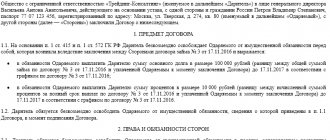Income tax when paying interest under a cash loan agreement
Expenses in the form of interest under a loan agreement (including if borrowed funds are used for the acquisition (creation) of depreciable property, for the acquisition of a share in the authorized capital) are taken into account by the borrower as part of non-operating expenses, provided that they are aimed at generating income (clause 2 Clause 1 of Article 265, Clause 1 of Article 252 of the Tax Code of the Russian Federation, Letter of the Ministry of Finance of Russia dated March 10, 2015 N 03-03-10/12339 (sent to the Federal Tax Service of Russia for information and use in the work of lower tax authorities by Letter dated March 23, 2015 N ГД-4-3/), dated 04/26/2013 N 03-03-06/1/14650, dated 02/27/2013 N 03-08-05/5690, Federal Tax Service of Russia dated 09/29/2014 N ГД-4-3/19855 ).
In general, for profit tax purposes, interest calculated on the basis of the actual rate established by the agreement is recognized as an expense (clause 1 of Article 269 of the Tax Code of the Russian Federation).
Special rules should be applied in relation to interest on debt obligations that arose as a result of transactions recognized as controlled in accordance with the Tax Code of the Russian Federation (clause 1, clauses 1.1 - 1.3 of Article 269 of the Tax Code of the Russian Federation), as well as in relation to controlled debt according to paragraphs 2 – 6 of Art. 269 of the Tax Code of the Russian Federation (taking into account the norms of paragraphs 7 - 13 of Article 269 of the Tax Code of the Russian Federation). In this material we do not consider interest on these transactions and on controlled debt.
Thus, to include interest under a loan agreement in expenses, as a general rule, the borrower does not calculate the maximum interest amount. Interest in this case is taken into account in full.
It is possible that borrowed funds are used to pay dividends. The Presidium of the Supreme Arbitration Court of the Russian Federation, in Resolution No. 3690/13 dated July 23, 2013 in case No. A40-41244/12-99-222, formed a legal position on the issue of accounting for expenses in the form of interest on such a loan when taxing profits. It lies in the fact that the payment of dividends is associated with activities aimed at generating income, and therefore interest on the loan that was raised to pay dividends reduces the tax base for income tax. These interests are recognized as non-operating expenses based on paragraphs. 2 p. 1 art. 265 Tax Code of the Russian Federation. This position is reflected in the Review of the practice of considering tax disputes by the Presidium of the Supreme Arbitration Court of the Russian Federation, the Supreme Court of the Russian Federation and the interpretation of the norms of legislation on taxes and fees contained in the decisions of the Constitutional Court of the Russian Federation for 2013. This Review was sent to the tax authorities for use in their work by Letter of the Federal Tax Service of Russia dated December 24, 2013 N SA-4-7/23263.
A similar approach to resolving the issue under consideration is expressed in Letters of the Ministry of Finance of Russia dated November 3, 2015 N 03-03-06/1/63388, dated July 24, 2015 N 03-03-06/1/42780. The financial department clarified that for income tax purposes, interest on a loan used to pay dividends is recognized as non-operating expenses based on paragraphs. 2 p. 1 art. 265 Tax Code of the Russian Federation. This position is supported by reference to the Resolution of the Presidium of the Supreme Arbitration Court of the Russian Federation dated July 23, 2013 N 3690/13.
Thus, interest on debt obligations (including loans and borrowings) in the case of using the corresponding raised funds to pay dividends is taken into account when taxing profits.
Previously, the Russian Ministry of Finance adhered to a different point of view (see Letters dated 05/06/2013 N 03-03-06/1/15774, dated 03/18/2013 N 03-03-06/1/8152). It was that expenses in the form of interest on a debt obligation raised to pay dividends are not recognized when determining the tax base for income tax, since such expenses were not made for the purpose of generating income.
In tax accounting, interest on a loan agreement is taken into account by the borrower on the date of recognition of the expense in accordance with Chapter. 25 of the Tax Code of the Russian Federation (clause 3 of Article 328 of the Tax Code of the Russian Federation). Thus, if the borrower uses the accrual method, then under a loan agreement, the validity of which falls on more than one reporting (tax) period, the amount of interest is expensed at the end of each month of the corresponding reporting (tax) period, regardless of the date (terms) of such payments provided for by the contract (clause 8 of article 272, clause 4 of article 328 of the Tax Code of the Russian Federation). Thus, interest is taken into account as part of non-operating expenses evenly throughout the entire term of the loan agreement, regardless of the date of their actual payment - at the end of each month of use of funds (Letter of the Federal Tax Service of Russia dated February 16, 2015 N GD-4-3/2289, Ministry of Finance of Russia dated January 21, 2015 N 03-03-06/1/1521, dated April 10, 2014 N 03-03-06/1/16339).
In the event that the loan agreement expires (the loan is repaid) within a calendar month, the amount of interest is included in expenses on the date of termination of such an agreement (loan repayment) (clause 8 of Article 272 of the Tax Code of the Russian Federation).
Note: if the loan agreement stipulates that the fulfillment of the obligation under it depends on the value (or other value) of the underlying asset with the accrual of a fixed interest rate during the validity period of the agreement, then on the last day of each month of the corresponding reporting (tax) period the borrower recognizes expenses in the form of interest at a fixed rate. In this case, expenses actually incurred based on the current value (or other value) of the underlying asset are taken into account as of the date of fulfillment of the obligation under this agreement (clause 8 of Article 272 of the Tax Code of the Russian Federation).
Income tax when paying interest under a loan agreement, the amount of which is expressed in foreign currency (cu), but was actually received in rubles
The borrower, according to the general rule, takes into account as expenses interest under the loan agreement, calculated on the basis of the actual rate established by the agreement (paragraph 2, paragraph 1, article 269 of the Tax Code of the Russian Federation).
When applying the accrual method in tax accounting, interest obligations expressed in foreign currency (conventional monetary units) are recalculated into rubles on the date the obligation arose, on the date of termination (fulfillment) of obligations and (or) on the last day of the current month, depending on what happened before. Recalculation of obligations (accounts payable) to the lender is carried out on the specified dates at the rate of the Bank of Russia or at another rate established by law or agreement of the parties (paragraph 2, 3, paragraph 8, article 271, paragraph 2, 3, paragraph 10, article 272 Tax Code of the Russian Federation). Due to changes in the exchange rate of foreign currency (conventional monetary units) to the ruble, exchange rate differences arise in settlements with the lender. A positive exchange rate difference occurs when liabilities are devalued, and a negative difference occurs when they are revalued. Such differences are included in non-operating income or non-operating expenses, respectively (clause 11 of article 250, subclause 5 of clause 1 of article 265 of the Tax Code of the Russian Federation).
Exchange differences are recognized as part of non-operating income or non-operating expenses on the date of termination (fulfillment) of obligations and (or) on the last day of the current month, depending on what happened earlier (clause 7, clause 4, paragraph 2, clause 8, art. 271, paragraph 6, paragraph 7, paragraph 2, paragraph 10, article 272 of the Tax Code of the Russian Federation).
Income tax when paying interest under a loan agreement, the amount of which is expressed and actually received in foreign currency
The borrower, according to the general rule, takes into account as expenses interest under the loan agreement, calculated on the basis of the actual rate established by the agreement (paragraph 2, paragraph 1, article 269 of the Tax Code of the Russian Federation).
Expenses in the form of interest payable in foreign currency must be recalculated into rubles (paragraph 1, paragraph 3, paragraph 5, article 252 of the Tax Code of the Russian Federation). For profit tax purposes, this recalculation is made at the official rate established by the Bank of Russia on the date of recognition of the corresponding expense (paragraph 1, clause 10, article 272 of the Tax Code of the Russian Federation).
When applying the accrual method, interest payment obligations expressed in foreign currency are recalculated into rubles on the date the obligation arose, on the date of termination (fulfillment) of obligations and (or) on the last day of the current month, whichever occurred first. Recalculation of obligations (accounts payable) to the lender is carried out on the specified dates at the Bank of Russia exchange rate (paragraph 2, paragraph 8, article 271, paragraph 2, paragraph 10, article 272 of the Tax Code of the Russian Federation). Due to changes in the exchange rate of foreign currency to the ruble, exchange rate differences arise in settlements with the lender. A positive exchange rate difference occurs when liabilities are devalued, and a negative difference occurs when they are revalued. Such differences are included in non-operating income or non-operating expenses, respectively (clause 11 of article 250, subclause 5 of clause 1 of article 265 of the Tax Code of the Russian Federation).
Exchange differences are recognized as part of non-operating income or non-operating expenses on the date of termination (fulfillment) of obligations and (or) on the last day of the current month, depending on what happened earlier (clause 7, clause 4, paragraph 2, clause 8, art. 271, paragraph 6, paragraph 7, paragraph 2, paragraph 10, article 272 of the Tax Code of the Russian Federation).
Legislation of the Russian Federation on taxation between legal entities
The main documents regulating loan agreements between legal entities, as well as taxation arising as a result of the loan agreement, are the Civil Code and the Tax Code of the Russian Federation.
Additionally, you can use the relevant Letters of the Ministry of Finance of the Russian Federation. In resolving complex issues, you can rely on previously obtained court decisions relating to directly necessary issues.
For example, the Letter of the Ministry of Finance dated 05.11.12, numbered 03-03-06/1/239, states that when a legal entity receives an interest-free loan, the organization does not receive any material benefit.
All loan agreements concluded between legal entities must be drawn up in strict accordance with existing legislation.
Each enterprise (borrower and lender) must independently understand the taxation of the loan agreement, based on the basic conditions of the latter, and bear full responsibility for the timely and correct payment of the relevant taxes.
About who can be a client in the Protect Finance loan company is described in the article: Protect Finance. For the main nuances of drawing up an agreement on debt forgiveness between legal entities, see the page.
Read reviews about a loan secured by real estate in the comments.
Withholding personal income tax when paying interest under a loan agreement
Income in the form of interest under a loan agreement received by an individual (lender) - a tax resident of the Russian Federation, who is not an individual entrepreneur, is recognized as an object of taxation and is taken into account when determining the tax base for personal income tax (clause 1, clause 1, article 208, clause 1 Article 209, paragraph 1 of Article 210 of the Tax Code of the Russian Federation). An organization that has received a loan from an individual (including from its founder or from an employee) and pays him interest is obliged, as a tax agent, to calculate, withhold from the individual and pay personal income tax to the budget on the amount of such income (clause 1 , 2 Article 226 of the Tax Code of the Russian Federation). Calculation of personal income tax on income in the form of interest received by an individual who is a tax resident of the Russian Federation is carried out at a tax rate of 13% (clause 1 of Article 224 of the Tax Code of the Russian Federation).
Based on clause 3 of Art. 210 of the Tax Code of the Russian Federation, when determining the tax base for personal income tax, a taxpayer (individual) has the right to receive standard tax deductions in the manner prescribed by Art. 218 Tax Code of the Russian Federation. These deductions are provided to him upon actual payment of income in the form of interest on the loan for each month of the tax period in which the agreement was in force.
If income in the form of interest under a loan agreement is received in cash, the date of its actual receipt is determined as the day of payment of interest, including their transfer to the taxpayer’s bank accounts or, on his behalf, to the accounts of third parties (clause 1, clause 1, art. 223 of the Tax Code of the Russian Federation). The tax agent organization is obliged to withhold the accrued amount of personal income tax directly from the income of an individual (lender) upon actual payment (clause 4 of Article 226 of the Tax Code of the Russian Federation).
The organization is obliged to transfer the amount of calculated and withheld personal income tax no later than the day following the day the income is paid to the taxpayer (clause 6 of Article 226 of the Tax Code of the Russian Federation).
Controlled debt
In Art. 269 of the Tax Code of the Russian Federation, there is a rather complex rule for determining controlled debt, directed against foreign legal entities and individuals who can replace dividends received from Russian companies with interest accrued on the debt. This substitution is very beneficial for Russian companies, since interest is taken into account when calculating income tax, but dividends are not.
According to Art. 269 of the Tax Code of the Russian Federation, a special procedure for recognizing interest on debt obligations is applied when paying interest income by Russian companies with outstanding debt:
— under a debt obligation to a foreign company that directly or indirectly owns more than 20% of the authorized capital of this Russian organization;
— on a debt obligation to a Russian company recognized in accordance with the legislation of the Russian Federation as an affiliate of the above-mentioned foreign company;
— on a debt obligation in respect of which such an affiliate or the foreign company itself acts as a guarantor, guarantor or otherwise undertakes to ensure the fulfillment of the debt obligation.
Any of the above options is recognized for the purposes of Art. 269 of the Tax Code of the Russian Federation controlled debt to a foreign company.
In this case, this article establishes a special rule: interest paid in excess of the maximum level calculated on the basis of the capitalization ratio and the share of participation of the foreign parent company in the Russian one is considered as a payment of dividends and is taxed at the appropriate tax rate.
Interest is taken to reduce the taxable profit of a Russian company as part of tax deductions, also taking into account the capitalization rule. If a Russian company has a controlled debt to a foreign company and the amount of outstanding debt obligations is more than three times (and for banks and leasing companies - more than 12.5 times) the difference between the amount of its assets and the amount of liabilities on the last day reporting or tax period, when determining the maximum amount of interest to be included in expenses, taking into account the provisions of paragraph 1 of Art. 269 of the Tax Code of the Russian Federation, special rules apply (the difference between the amount of assets and the amount of liabilities of the company is called equity capital).
If the above circumstances occur, a Russian company is obliged, on the last day of each reporting or tax period, to calculate the maximum amount of interest recognized as an expense on controlled debt by dividing the amount of interest accrued by the taxpayer in each reporting or tax period on controlled debt by the capitalization ratio.
The capitalization ratio is calculated as of the last reporting date of the reporting or tax period by dividing the amount of outstanding controlled debt by the amount of equity capital corresponding to the share of direct or indirect participation of a foreign company in the authorized capital of a Russian organization, and dividing the result by three. For banks and leasing companies, the divisor is 12.5.
When determining the amount of equity capital, the amount of debt obligations in the form of debts on taxes and fees, including current debt for their payment, amounts of deferrals, installments and investment tax credits are not taken into account.
After determining the amount of maximum interest recognized as expenses, you need to calculate the difference between the actually accrued and the maximum interest.
The positive difference is equated for tax purposes to dividends paid to a foreign company in respect of which there is controlled debt, and is subject to income tax. This is stated in paragraph 4 of Art. 269 of the Tax Code of the Russian Federation. As a general rule, the rate given in clause 3 of Art. 284 of the Code, i.e. 15%.
However, if existing double taxation agreements provide for reduced rates for dividends paid to a foreign company, then subject to all other conditions of the agreement - the size of the share in the authorized capital, confirmation of residence, etc. - you need to use them.
Example. A foreign company registered in the United States provided a loan of $200,000 to the Russian Triathlon LLC.
In accordance with the agreement, interest is paid annually based on a rate of 20% per annum.
At the end of 2009, interest was accrued in the amount of $40,000 ($200,000 x 20%). On the date of accrual, the dollar exchange rate established by the Bank of Russia was 30.2442 rubles/dollar. Thus, in Russian rubles the amount of accrued interest is RUB 1,209,768.
The American company owns 45% of the authorized capital of the Russian company.
At the end of 2009, the equity capital of the Russian company was equal to 1,460,000 rubles.
The amount of equity capital corresponding to the share of participation of an American company in the authorized capital of a Russian organization is 657,000 rubles. (RUB 1,460,000 x 45%).
The capitalization ratio is 3.0689 ($200,000 x RUB 30.2442/USD: 3: RUB 657,000).
The maximum amount of interest included in expenses, calculated in accordance with clause 2 of Art. 269 of the Tax Code of the Russian Federation is 394,202 rubles. (RUB 1,209,768: 3.0689).
In accordance with the Treaty between the Russian Federation and the United States for the avoidance of double taxation and the prevention of tax evasion with respect to taxes on income and capital of June 17, 1992, dividends may be taxed in Russia, but the tax levied in such a case will not exceed:
- 5% of the gross amount of dividends, if the person actually entitled to them is a company owning at least 10% of the shares with voting rights (or, in relation to Russia, if there are no shares with voting rights, at least 10% of the charter capital) of the company paying dividends;
— 10% of the gross amount of dividends in all other cases.
The positive difference between the actually paid and the maximum interest calculated in accordance with clause 2 of Art. 269 of the Tax Code of the Russian Federation is 815,566 rubles. (1,209,768 – 394,202). For tax purposes, this amount is treated as dividends and is subject to income tax at a rate of 5%. The amount of tax withheld will be equal to 40,778 rubles. (RUB 815,566 x 5%).
Accounting for interest under a cash loan agreement (accrual and payment)
The procedure for accounting for interest on a loan depends on the purpose for which the borrowed funds were used:
– when borrowed funds are used for the acquisition, construction and (or) production of an investment asset, interest is included in the cost of this asset (paragraph 2, clause 7, clause 9 of PBU 15/2008) <*>.
The inclusion of interest in the initial cost of an investment asset ceases from the first day of the month following the month of termination of the acquisition, construction and (or) production of the investment asset or the month of the beginning of its use for the manufacture of products, performance of work, provision of services (despite the incompleteness of the acquisition work, construction and (or) production of an investment asset) (clauses 12, 13 of PBU 15/2008);
– in other cases, interest is taken into account as part of other expenses (clause 7 of PBU 15/2008).
The specified procedure for accounting for interest on a loan does not depend on how their amount is determined: using the simple or compound interest formula.
In accounting, interest payable is reflected in separate subaccounts for the credit of account 66 “Settlements for short-term loans and borrowings” (when receiving a loan for a period of no more than 12 months) or account 67 “Settlements for long-term loans and borrowings” (when receiving a loan for period of more than 12 months) (Instructions for using the Chart of Accounts). Due to the different procedures for recognizing interest in accounting and tax accounting, differences may arise that are taken into account according to the rules established by PBU 18/02.
If borrowed funds are used to acquire (create) an investment asset, taxable temporary differences (TDT) and deferred tax liabilities (DTL) arise in accounting. This is due to the fact that in tax accounting interest is taken into account as an expense on a monthly basis, and in accounting accounting - as depreciation is calculated on an investment asset acquired (created) using borrowed funds. At the same time, the specified NVR and IT are repaid (clauses 12, 15, 18 PBU 18/02).
| Debit | Credit | Contents of operations |
| 1. Borrowed funds are used to purchase (create) an investment asset <*> | ||
| 08 | 66 (67) | Accrued interest due |
| 68 | 77 | IT is reflected (in terms of interest that is recognized in tax accounting, and accounting profit will be formed in subsequent reporting periods) |
| 66 (67) | 51 | Interest paid on loan |
| 01 | 08 | The acquired (created) investment asset is accepted for accounting |
| 20 (44) | 02 | Depreciation has been accrued on the investment asset accepted for accounting <**> |
| 77 | 68 | IT has been reduced |
| 2. Borrowed funds are used for purposes other than those indicated above | ||
| 91-2 | 66 (67) | Accrued interest due <***> |
| 66 (67) | 51 | Interest paid on loan |
——————————–
<*> An investment asset is understood as an object of property, the preparation of which for its intended use requires a long time and significant expenses for acquisition, construction and (or) production. Investment assets include objects of unfinished production and construction in progress, which will subsequently be accepted for accounting by the borrower and (or) customer (investor, buyer) as fixed assets (including land), intangible assets or other non-current assets (paragraph 3 p. 7 PBU 15/2008).
<**> In this case, we proceed from the assumption that depreciation is taken into account monthly when forming accounting profit (loss).
<***> The same entry reflects the accrual of interest on loans used for the acquisition (creation) of an investment asset, after the termination of the acquisition, construction and (or) production of the investment asset or the beginning of its use for the manufacture of products, performance of work, provision of services (despite on the incompleteness of work on the acquisition, construction and (or) production of an investment asset).
Accounting for the payment of interest under a loan agreement, the amount of which is expressed in foreign currency (cu), but was actually received in rubles
For accounting purposes, differences that relate to interest on loans denominated in currency. e., and are formed from the moment interest is accrued under the terms of the agreement until their actual repayment (transfer), are exchange rate and are taken into account as part of other expenses or income. Thus, in the event of an increase in the exchange rate from the date of accrual of interest to the date of their payment, negative exchange rate differences are formed, which are reflected in accounting as part of other expenses (clause 11 of PBU 10/99, clauses 1, 3 - 7, 11 - 13 PBU 3/2006). In the event of a decrease in the exchange rate from the date of accrual of interest to the date of payment, positive exchange differences arise in accounting, which are included in other income on the basis of clause 7 of PBU 9/99, clauses 1, 3 - 7, 11 - 13 of PBU 3 /2006.
| Debit | Credit | Contents of operations |
| 1. Borrowed funds are used to purchase (create) an investment asset <*> | ||
| 08 | 66 (67) | Interest accrued on the loan for the past month |
| 68 | 77 | IT is reflected |
| 66 (67) | 51 | Interest on the loan was paid in the month following the month of their accrual |
| 91-2 | 66 (67) | Negative exchange rate difference on interest is reflected (if the exchange rate increases) |
| 66 (67) | 91-1 | Positive exchange rate differences in interest are reflected (if the exchange rate decreases) |
| 2. Borrowed funds are used for purposes other than those indicated above | ||
| 91-2 | 66 (67) | Interest accrued on the loan for the past month |
| 66 (67) | 51 | Interest on the loan was paid in the month following the month of their accrual |
| 91-2 | 66 (67) | Negative exchange rate difference on interest is reflected (if the exchange rate increases) |
| 66 (67) | 91-1 | Positive exchange rate differences in interest are reflected (if the exchange rate decreases) |
Accounting for the payment of interest under a loan agreement, the amount of which is expressed and actually received in foreign currency
For accounting purposes, differences that relate to interest on loans denominated and received in foreign currency, and are formed from the moment interest is accrued under the terms of the agreement until their actual repayment (transfer), are exchange rates and are taken into account as part of other expenses or income. Thus, in the event of an increase in the exchange rate from the date of accrual of interest to the date of their payment, negative exchange rate differences are formed, which are reflected in accounting as part of other expenses (clause 11 of PBU 10/99, clauses 1, 3 - 7, 11 - 13 PBU 3/2006). In the event of a decrease in the exchange rate from the date of accrual of interest to the date of payment, positive exchange differences arise in accounting, which are included in other income on the basis of clause 7 of PBU 9/99, clauses 1, 3 - 7, 11 - 13 of PBU 3 /2006.
| Debit | Credit | Contents of operations |
| 91-2 | 66 (67) | Interest accrued on the loan for the past month |
| 66 (67) | 52 | Interest on the loan was paid in the month following the month of their accrual |
| 91-2 | 66 (67) | Negative exchange rate difference on interest is reflected (if the exchange rate increases) |
| 66 (67) | 91-1 | Positive exchange rate differences in interest are reflected (if the exchange rate decreases) |
Accounting for payment of interest under a loan agreement received from an individual
The deduction of the accrued amount of personal income tax from the income (in the form of interest on a loan) of the lender - an individual is reflected in the debit of account 66 “Settlements for short-term loans and borrowings” (or 67 “Settlements for long-term loans and borrowings”) in correspondence with the credit of the account 68 “Calculations for taxes and fees” (Instructions for using the Chart of Accounts).
| Debit | Credit | Contents of operations |
| 66 (67) | 68 | Personal income tax calculated from the lender’s income is withheld |
| 68 | 51 | Withheld personal income tax transferred to the budget |
| 66 (67) | 50 (51) | Interest paid on the loan minus withheld personal income tax |
"Space" art. 269 Tax Code of the Russian Federation
For the purposes of calculating income tax in accordance with paragraph 1 of Art. 269 of the Tax Code of the Russian Federation, are debt obligations received in the same currency for comparable periods in comparable amounts under the same security from one creditor or lender comparable?
In the Letter of the Ministry of Finance of Russia dated February 25, 2010 N 03-03-06/1/88, financiers did not have the courage to give a specific answer.
On the uncertainty of the text of paragraph 1 of Art. 269 of the Tax Code of the Russian Federation, experts have pointed out for a long time. Vague definitions of debt comparability can play a cruel joke not only on taxpayers, but also on the tax authorities themselves.
As stated in paragraph 1 of Art. 269, for profit tax purposes, interest accrued on a debt obligation of any type is recognized as an expense, provided that the amount of interest accrued by the taxpayer on the debt obligation does not significantly deviate from the average level of interest charged on debt obligations issued in the same quarter on comparable terms (or in the same month - for taxpayers who switched to calculating monthly advance payments based on the actual profit received).
Debt issued on comparable terms means obligations issued in the same currency and for the same terms in comparable amounts against similar collateral. Thus, financiers agree, debt obligations issued by:
— in one currency;
- for the same period;
— in comparable volumes;
- under similar security.
If issued credits or borrowings simultaneously meet all of the listed criteria, they are recognized for income tax purposes as comparable debt obligations.
What changes if these loans are from the same lender? Judging by the eloquent silence of the financiers, nothing.
So, if you simply divide the loan amount into two parts and conclude two independent agreements with the same lender, the amount of interest accrued on them can be recognized in the tax accounting of the borrower in full, without restrictions?
Oddly enough, but this is true.
UTII
The object of UTII taxation is imputed income (clause 1 of Article 346.29 of the Tax Code of the Russian Federation). Therefore, neither the money (property) issued to the borrower nor the interest received on the loan will affect the tax base for UTII.
Situation: is it necessary to charge income tax on the amount of interest on a loan issued if the organization is transferred to pay UTII?
Yes need.
Operations related to the provision of loans go beyond the scope of activities with which an organization can pay UTII (clause 2 of Article 346.26 of the Tax Code of the Russian Federation, letter of the Ministry of Finance of Russia dated May 14, 2008 No. 03-11-05/122). Accounting for income and expenses for such operations must be kept separately (Clause 7, Article 346.26 of the Tax Code of the Russian Federation). Include interest on the loan received from the borrower in non-operating income. The amount of this income must be taken into account when calculating income tax (clause 6 of Article 250 of the Tax Code of the Russian Federation).










